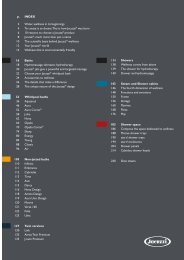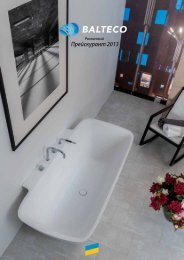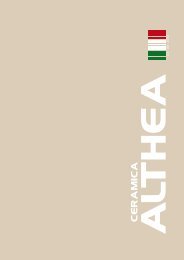Create successful ePaper yourself
Turn your PDF publications into a flip-book with our unique Google optimized e-Paper software.
duly aged, and neither frozen nor too hot. Always follow the instructions of grout and adhesive manufacturers. Cement-based adhesives must be applied at room temperature,<br />
ranging from +5° C to + 30/35° C. Respect the technical times indicated by the adhesive and grout manufacturers. During installation, do not mark the ceramic material with<br />
pencils or indelible pens, especially on polished material.<br />
Joint and grout lines<br />
The width of grout lines can vary depending on the size of the tiles and their destination of use. In general, <strong>Marca</strong> <strong>Corona</strong> recommends avoiding a joint-less installation and<br />
suggests allowing a 2-3mm grout line. When using epoxy grouts, resins or the like, we recommend carrying out a preliminary cleaning test. For a better aesthetic outcome, we<br />
suggest the use of grouts of the same colour hue as the tiles in order to reduce the colour contrast. After grouting, immediately and carefully remove excess grout using a wet<br />
sponge and abundant water. A few days after installation, carry out a general cleaning using a padding action acid detergent in order to remove all residues (see “Cleaning after<br />
installation”)<br />
Cleaning after installation<br />
Once installation is completed, a general cleaning operation is necessary. Incorrect or late removal of grout residue can cause rims and stains which are difficult to remove or<br />
create a cement-film on the floor which may absorb impurities and result in a dirty effect on the floor or wall. In order to remove grout residue, wash the floor with a solution of<br />
water and DETERDEk (FILA). Leave the product to act on the wet floor and wipe it using a colourless cloth; then rinse it with abundant water. If necessary, repeat the operation<br />
again. <strong>Marca</strong> <strong>Corona</strong> recommends carrying out a preliminary cleaning on a sample tile or part of surface, then proceeding with the cleaning of the entire surface. After this<br />
operation, it is necessary to carry out a base and/or alkaline washing using detergents with a degreasing action, in order to eliminate oily traces on the floor.<br />
Every day cleaning<br />
For every day cleaning, we recommend the use of FILA CLEANER neutral detergent diluted 1:1200 in hot water (2-3 caps of product every 5 litre water), frequently rinse the<br />
cloth and/or the mop in order to avoid excess water on the floor. More aggressive detergents and/or clothes that have not been perfectly rinsed, can cause marks, opacification<br />
and stains on the floor. Do not use wax, oily soaps, impregnating detergents and other treatments on porcelain stoneware tiles. Some detergents available on the market contain<br />
wax and polishing additives which, if used, can cause a film on the floor. In order to restore the original look of the floor and eliminate this film, it is necessary to de-wax the<br />
floor suing specific products. <strong>Marca</strong> <strong>Corona</strong> reminds you that hydrofluoric acid (hF) can irreversibly damage porcelain stoneware.<br />
Extraordinary cleaning<br />
In case of particularly bad stains, we recommend washing with a solution of FILA PS/87 diluted 1:10 in water, then rinsing. <strong>Marca</strong> <strong>Corona</strong> recommends carrying out a preliminary<br />
cleaning test before using these products, especially for honed and polished porcelain stoneware surfaces.<br />
255

















